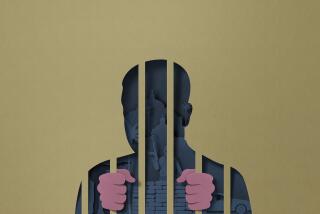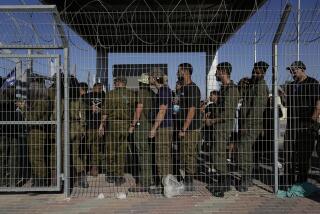Historian Tells of ‘Stomping’ by Nazi Guard
A La Habra man facing deportation for serving as a Nazi concentration camp guard allegedly beat up and “stomped” two Yugoslav prisoners before they were shot to death, the Justice Department’s chief historical expert testified in Immigration Court here on Wednesday.
The department’s Office of Special Investigations is seeking to deport Bruno Karl Blach, 65, for his role as a dog handler and concentration camp guard during World War II. Government prosecutors claim that Blach, a native of Czechoslovakia, lied to immigration officials about his military record when he entered the United States in 1956.
The witness, Charles W. Sydnor Jr., president of Emory and Henry College in Emory, Va., and a specialist in Nazi history, quoted from a book published in Germany during his testimony.
In the spring of 1945, as the Soviet Army advanced, dog handlers and guards were assigned to kill 38 patients in the camp hospital who were too ill to march from the Wiener Neudorf concentration camp in Austria to its sister camp at Mauthausen, Sydnor said.
On April 2, a Capt. Stier allegedly ordered Blach and two others to track down two prisoners who had escaped from the hospital.
After finding the prisoners hiding in a barrack, “Mr. Blach, Mr. Kos and Mr. Wilhemsen knocked both of the prisoners to the floor and stomped them. . . . Thunke (another guard) shot them,” Sydnor said, translating in English after reading in German from a passage in the book “The History of the Camp Mauthausen.”
Sydnor testified that the passage was based on an account by Dr. Rolf Busch-Waldeck, a prisoner who also served as a Mauthausen camp physician; Soviet Army reports, and testimony from the allied forces’ trials of Nazi war criminals held in 1947.
Later, the witness continued, “the 38 bodies were assembled in the mortuary and together were buried in a sandy grave next to the potato cellar.”
“That’s crazy,” Blach said after Wednesday’s court session. He said the acts described in the book were done by others, not him.
Both Blach’s attorney, Ronald G. Parker, and federal prosecutors said they were unaware of the book until it was mentioned by Sydnor.
Parker characterized the passages as “garbage.”
“He definitely was there (as a Nazi camp guard),” Parker said of his client. “But, it’s a question of guilt by association. You can’t defend against the Holocaust.”
During the proceedings, Blach, a retired grocery clerk, has not denied his past as a concentration camp guard, but insists that he was a low-level private who was following orders and did nothing wrong.
“I didn’t have any choice. I had to do what they told me,” Blach said in a previous interview.
Blach joined the Nazi Party in January, 1939, according to Justice Department documents filed in court. He joined the elite Waffen-SS in 1940 and was assigned to the SS Totenkopf (Death’s Head Battalion) at Dachau in Germany. He served there until the summer or fall of 1943 and moved on to Wiener Neudorf in Austria, serving there into 1945.
In 1951, Blach applied for admission to the United States under the Displaced Persons Act, but an investigation by the U.S. Army’s Counter Intelligence Corps revealed Blach’s true military record and his application was rejected, according to the government’s order to show cause, the first step required for deportation.
In 1956, Blach fraudulently gained admission to this country, the government contends. Bruce Einhorn, the senior trial attorney in the Blach matter, said this “case ranks among the strongest in my six years of experience with the department.”
Einhorn said he plans to submit 101 exhibits and present several concentration camp survivors as witnesses during the trial before U.S. Immigration Judge James P. Vandello.
Detailed descriptions of life in the camps were provided by Sydnor, who finished three days of testimony Wednesday.
“The dog handlers did most, if not all, of the shooting of prisoners who fell out of line (on the march),” Sydnor said.
In explaining his expertise, the witness said he has spent 16 years traveling and studying Nazi-era material--including the book quoted Wednesday--from seven historical archives.
In 1945, between March 27 and April 14, about 2,000 concentration camp prisoners were forced to marched from Wiener Neudorf to Mauthausen, he said.
Sydnor added that an investigation by the West German government backs up the truth of the passages he read in court Wednesday.
The witness said the American Army was not prepared for what it found when it liberated Dachau.
“There were thousands of corpses in boxcars and 10,000 people lying in the open, dead or dying,” Sydnor said. He said U.S. Army military police “arrested, detained and interrogated” every soldier and official they could find at the camp. Parker asked Sydnor whether it was unusual that a person (like Blach), believed to be responsible for 38 murders, could go unnoticed for 25 years.
“It is not unusual for people to be appearing on wanted lists even now,” Sydnor replied.
About a dozen concentration camp survivors and their children attended Wednesday’s court session.
“It is a matter of justice not to bury this,” said Anna Fischer, a docent at the Martyrs Memorial and Museum of the Holocaust on Wilshire Boulevard.
More to Read
Sign up for Essential California
The most important California stories and recommendations in your inbox every morning.
You may occasionally receive promotional content from the Los Angeles Times.









